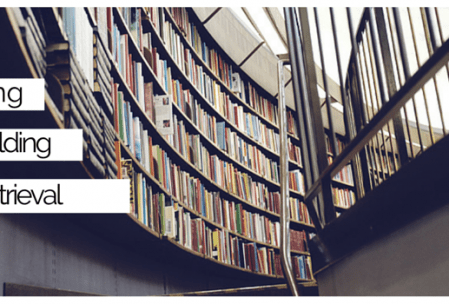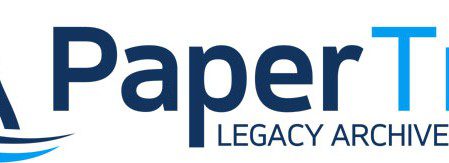This weekend marks the 50th anniversary of the New Lodge Six Massacre.
The Massacre began with the assassination of two teenagers at the top of New Lodge Road outside Lynch's Bar just before midnight on 3rd February 1973.
The two teenagers, Jim McCann and Jim Sloan, were IRA volunteers although they were out socialising and were not armed.
They died in a hail of bullets fired from a passing car in what first appeared to be - or was supposed to appear to be - a random sectarian killing.
A few minutes later, another 3 local men were shot dead 150 meters away at the junction of Edlingham Street and New Lodge Road.
Shooters triangulated machine-gun fire from Loyalist Tiger's Bay and the top of a New Lodge tower block.
Tony “TC” Campbell who celebrated his 19th birthday on the night he was killed was hit first. He had joined the IRA a few weeks before but again witnesses testify he was unarmed and had been out socialising and celebrating his birthday.
Local men, Brendan Maguire, 32, was hit and killed when he went to TC’s aid. Then, John Loughran, 35, was shot and killed when he went to Brendan's aid.
Another local man, Charlie Carson, doing the same was badly injured by the same burst of gunfire but survived.
Ambrose Hardy was the sixth victim killed a couple of hours later in the same kill zone when he tried to get home to his mother. He had been waving a make-shift white flag above his head when targeted by a sniper from the flats.

ADMISSION
In the immediate aftermath of the New Lodge Six Massacre, the British Army claimed all of the killings but alleged all of the victims were gunmen killed in the midst of a gun battle between their troops and IRA "terrorists".
If John Loughran, Brendan Maguire, and Charlie Carson had been wearing British Army uniforms, they would have won Military Crosses for their selfless bravery.
On 5th February, Minister of State for Northern Ireland, David Howell, told the British Houses of Parliament:
“Six were killed during a major battle between the security forces and IRA gunmen in the New Lodge area on Saturday night”
Dozens of civilian eyewitnesses told a completely refuted the British Army's story and it was later proved that the victims were unarmed and posed no threat to their British army killers.
Read the New Lodge Six Community Report
Nevertheless, at the inquest on 27th March 1975, the Royal Ulster Constabulary (RUC) claimed that officers found the car used in the drive-by killing of the teenagers, Jim McCann and Jim Sloan, on 5th February 1973. This was the day that Howell told the British Parliament that all of the victims were gunmen killed by the British Armed Forces.
The cops pinned the first two killings on Loyalist extremists.
Police had allegedly discovered the vehicle close to Tennent Street police station in a Loyalist part of west Belfast. 8 bullets were taken out of the friends’ bodies and 8 bullet casings were found in the vehicle.
When interrogated by family counsel at the inquest, the police representative admitted “there is no direct evidence to show that this car was the car involved” (p.37, section 9 Community Inquiry).
On 6th February, the day after the car was allegedly found close to the police station, the police ran an appeal for information about the location of the car in the Irish News.
Regardless, neither the British army nor the British Minister of State ever retracted their statements claiming all of the killings.
Secret British state internal reports, intelligence summaries, and meetings Paper Trail discovered over the last decade show they claimed all six killings too.
SECRET BRITISH ARCHIVES
The British Army informed their Tory Prime Minister, Edward Heath, that its soldiers killed every one of the New Lodge Six victims. Heath had even initialed the file and dated it 9th February - 4 days after the RUC allegedly discovered the assassins' car.
“On Saturday 3 Feb the major violence took place in the New Lodge Road area where between 2345 and 0300 hrs 4 Feb an estimated 189 rounds were fired at SF [Security Forces] who returned 168 rounds and claimed 7 hits, 6 of the hits have been confirmed as bodies are [sic] in the RVH [Royal Victoria Hospital]. 5 of the 6 were known to the SF as members if [sic] the Provisional IRA or Fianna and there is an unconfirmed report of the involvement of the sixth.”

Three of the victims were IRA volunteers – TC had joined a few weeks before, but the British may not have known that until he was claimed by the IRA as a member.
All six were unarmed and posed no threat whatsoever to the British Army when they were killed.
PREVIOUS BRITISH ARMY ASSASSINATION ATTEMPT
Six months before the New Lodge Six Massacre, the British Army tried to assassinate Jim McCann as he stood on the doorstep of the home of Jim Sloan who was to die beside him in February 1973.
On Saturday 29th July, a sniper from 40 Commando, Royal Marines, shot him in the back from the same British Army sangar on the flats used by the British Army snipers of 1 Queens on the night of the New Lodge Six Massacre.
Again, the British Army alleged he was armed:
“New Lodge. 2 shooting incidents were reported, 1 of which involved SF. A gunman in Burlington St was fired at and was seen to fall. James McCann, 22 of Hartwell St was later admitted to the Mater with GSW and his condition was stated to be serious.”

Jim McCann was lucky to survive this attempt on his life and, when he recovered, he was not arrested or interned - this is proof in itself that the lie he was armed was spurious and without foundation.
Like 1 Queens later in the New Lodge, 40 Commando killed many civilians and unarmed IRA personnel in disputed circumstances during its tour of duty in the summer of 1972.
Just the night before this attempt on Jim McCann's life, a 40 Commando sniper killed IRA Volunteer Seamus Cassidy in similar circumstances. Again, the British Army claimed they killed a gunman whilst many civilian witnesses said Cassidy was unarmed and killed in cold blood.
Incidentally, Paper Trail is also examining other drive-by shootings during the same period and in the same area which have all the hallmarks of covert British Army Q Patrols.
They follow a similar pattern to murders and attempted mass murders committed by other undercover quick reaction units run by individual British Army battalions and extra-legal death squads like the Military Reaction Force attached to others.
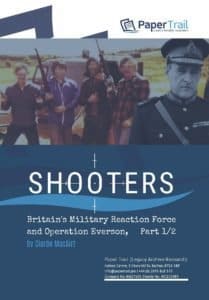
SHOOTERS
Britain's Military Reaction Force.

As it stands, RUC provided no proof that Vols. Sloan and McCann died as a result of a random sectarian shooting by pro-state Loyalists.
There is mounting proof that the victims were assassinated in the first part of a two-step British military operation.
Last year the families, their legal teams and Relatives for Justice secured new inquests for the six victims following a long, dignified campaign for truth.
Among the legal bundles submitted to the Coroner were hundreds of pages of new evidence relating to the New Lodge Six Massacre that Paper Trail discovered in The National Archives in London or battled for via the Freedom of Information Act since 2014.
New Evidence
The new evidence included information from over 400 secret British Ministry of Defence and Prime Ministerial files.
Our previous archival evidence proved that the British Army informed the British Prime Minister that it killed and injured all of the victims; the British Army had tried to assassinate and criminalize one of the victims six months before the Massacre; and the original inquest was misdirected by the RUC.
This most recent horde of new evidence gave the families critical evidence such as:
- The British Army units involved in the shootings
- Contemporaneous British military reports before, during and after the shootings
- British military intelligence and disinformation regarding the victims
- Suspicious cars in the vicinity
- British Army Public Relations Reports
- And much more which will be ventilated at the inquests
1st Battalion The Queen’s Regiment
Paper Trail discovered a tranche of new evidence relating to the Battalion involved in the killings – 1st Battalion The Queen’s Regiment (1 Queens) – and its military operation which led to the New Lodge Six Massacre.
1 Queen's was due to finish its tour of duty in New Lodge a few days later on 16th February 1973.
The bundle also included the British Military’s own investigation along with maps, British Army statements of each soldier involved and the cypher list with the rank and name of each soldier (redacted).
The statements and redacted names of each soldier who killed and injured the unarmed victims are there too, as are the redacted serial numbers of their guns so the British Ministry of Defence will not be able to claim the problems it had with tracing British Army shooters at the Ballymurphy Inquest.
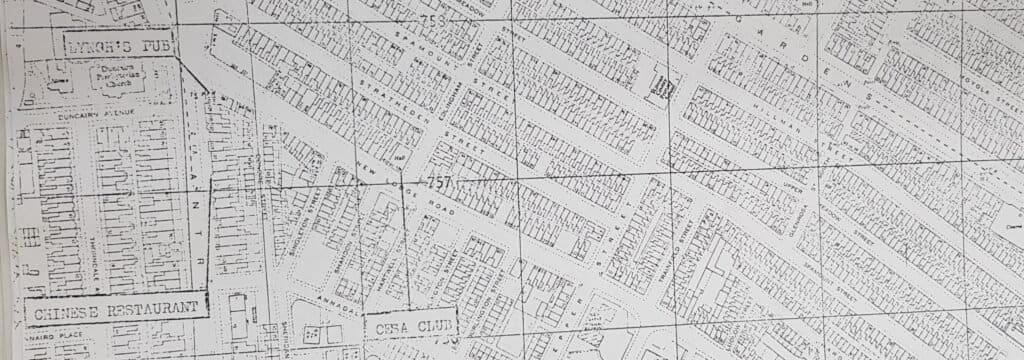
The other significant information related to:
- The Royal Military Police Special Investigation Branch review with soldier statements, maps, statistics, cyphers and weapon serial numbers
- British military reporting of the shootings
- Alleged 1 Queens movements, firing positions and actions throughout its operation
- Profiles and British military intelligence regarding the victims
- 1 Queen’s War Diary and Historical Record
- 1 Queen’s Post-Tour Report
- 1 Queen’s Regimental Journal
- Inter-Departmental communications and meetings discussing the killings
- Newspaper articles
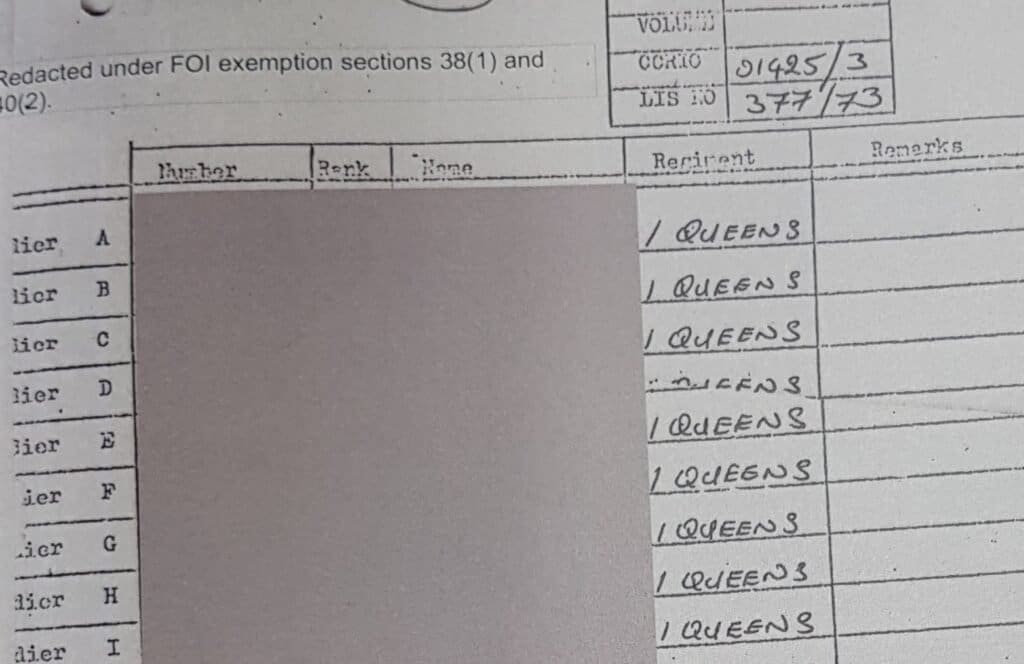
Additional Archival Evidence
As well as the statements of the British soldiers, the files also refer to the inclusion of the “authorised version” [Ministry of Defence emphasis] of the 1 Queens operation to the British Secretary of State for Northern Ireland.
Nick Evans was Assistant Civil Advisor to the General Officer Commanding, Lieutenant General Sir Frank King, who had just taken over control of the British Army in Northern Ireland from Lt. General Sir Harry Tuzo on 1st February 1973. On 9th February, Evans wrote to David Simmons of the MoD's Defence Secretariat 10 (DS10) regarding an official report into the Massacre:
'I can confirm that no actual brief as such was or is being prepared in this Headquarters. However I wrote on Thursday to the Secretary of State's officegiving the "authorized version" of these events.'
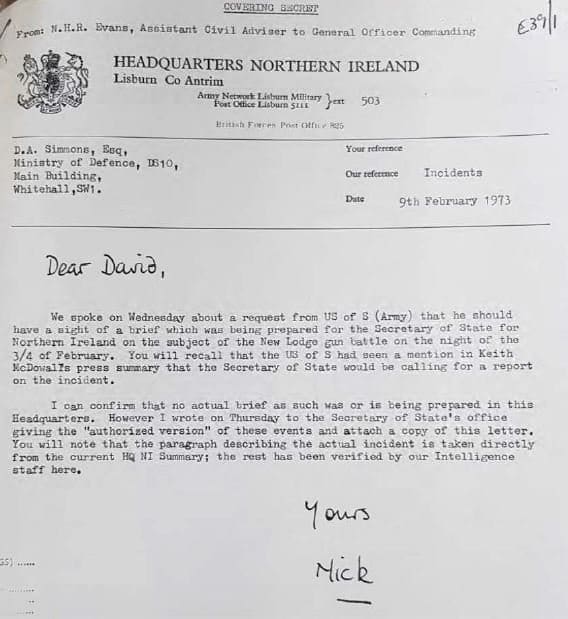
Additionally, evidence from the soldier’s statements includes references to the recognition and deliberate targeting of at least one victim and British Army contact with members of the Ulster Defence Association at barricades where shooting occurred in the Loyalist part of Edlingham Street.
Importantly too, the secret British Army files prove that 1 Queens took up firing positions in a pre-planned operation before the shootings and a regular British Army mobile patrol was indeed in the area of the first two shootings as local witnesses had testified.
The same disinformation peppers the archive discoveries, especially that relating to the British Army allegation that it killed all six victims during a gun battle with the Irish Republican Army.
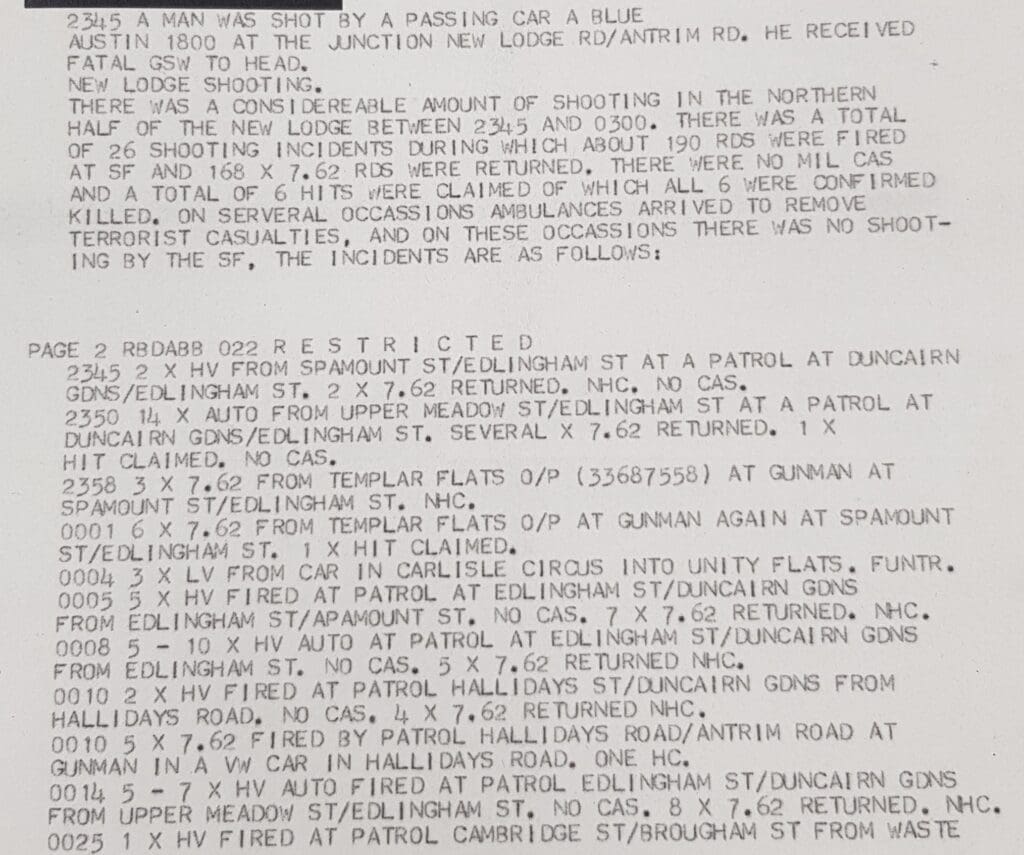
British Army Situation Report on the New Lodge Six MassacreCivilian witnesses have always strongly refuted this and the weight of new evidence supports them. They have remained steadfast for 50 years and will be vindicated if and when they receive a proper inquest.
Thoughts as always to the families who have supported many of our families over the years and have been an inspiration to the New Lodge community and beyond.
I am thinking particularly too today of the gentleman Willie Loughran who passed in April of 2022.


